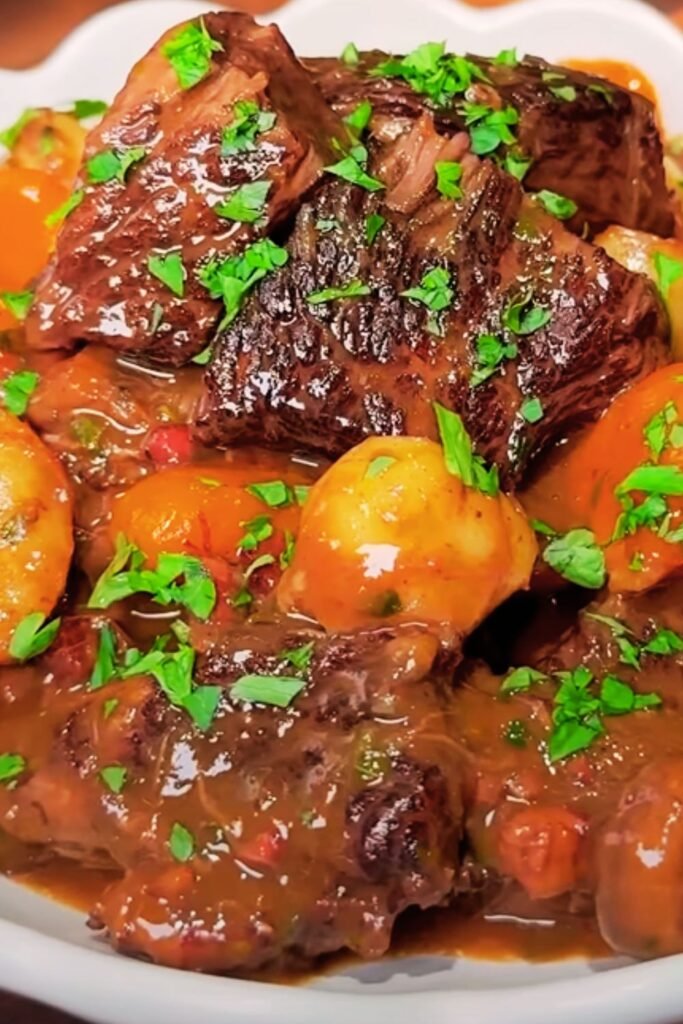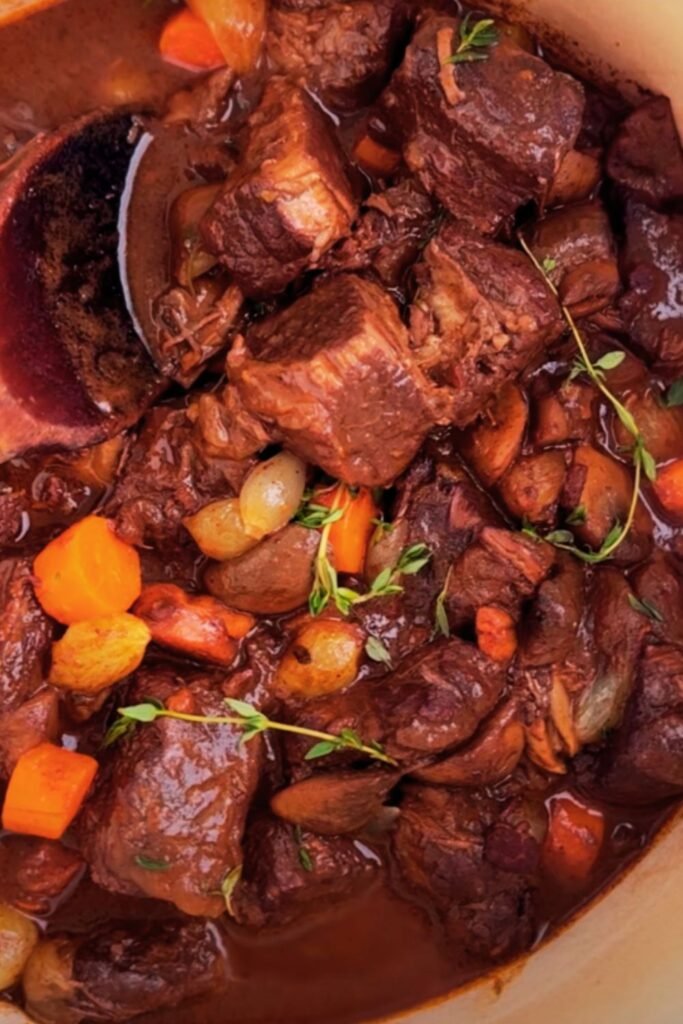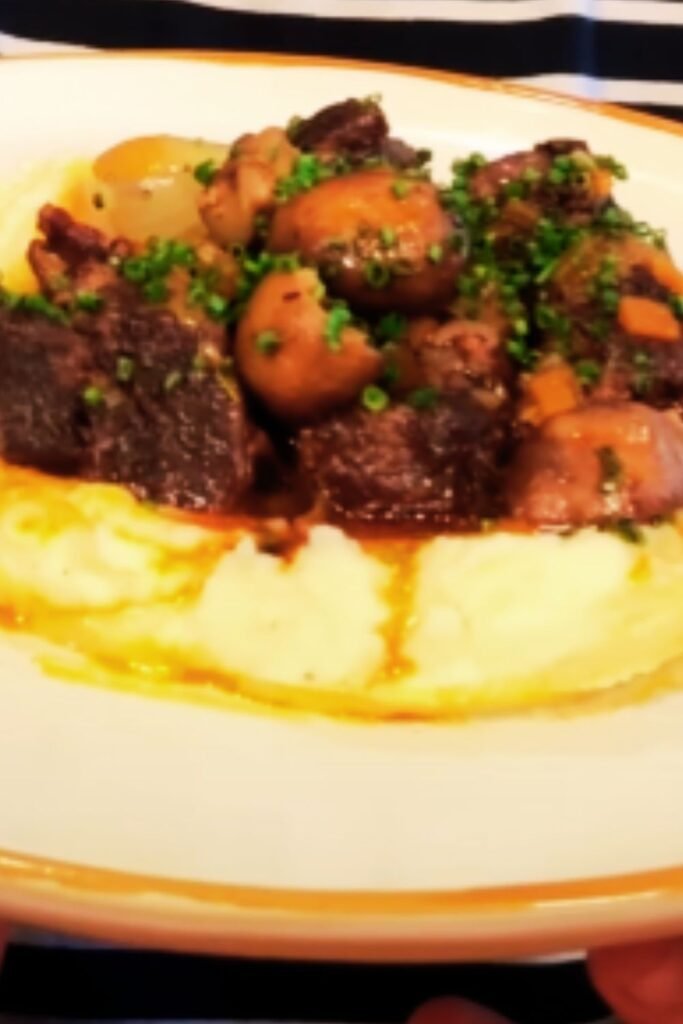When I first encountered beef bourguignon at a cozy bistro in Lyon, I knew I had to master this iconic French dish. The rich, wine-braised beef melting in my mouth, surrounded by tender vegetables and an incredibly flavorful sauce, was nothing short of magical. After years of perfecting my technique and learning from both French home cooks and professional chefs, I’m excited to share everything I know about creating this masterpiece in your own kitchen.
Beef bourguignon represents the essence of French provincial cooking – taking humble ingredients and transforming them through patience, technique, and love into something extraordinary. This isn’t just a recipe; it’s a journey into the heart of French culinary tradition that will fill your home with incredible aromas and create memories around your dinner table.
Understanding Beef Bourguignon: A Culinary Definition
Before we dive into cooking, let me clarify exactly what makes beef bourguignon special:
Beef Bourguignon : A traditional French braised beef dish originating from the Burgundy region, where beef is slowly cooked in red wine with vegetables, herbs, and aromatics until fork-tender.
Braising : A cooking method that combines both dry and moist heat, typically searing meat at high temperature then finishing in liquid at lower temperature in a covered pot.
Mirepoix : The classic French aromatic base of diced onions, carrots, and celery used to build flavor foundations in many dishes.
Bouquet Garni : A bundle of herbs (typically thyme, bay leaves, and parsley) tied together or wrapped in cheesecloth for easy removal after cooking.
Lardons : Small strips or cubes of bacon or salt pork used to add richness and depth to French dishes.
The beauty of beef bourguignon lies in its simplicity and the way time transforms ordinary ingredients into something sublime. Every component plays a crucial role in building layers of flavor that make this dish so memorable.
Selecting Your Ingredients: Quality Makes the Difference
My experience has taught me that ingredient selection can make or break your beef bourguignon. Here’s what I’ve learned about choosing the best components:
The Perfect Cut of Beef
I always reach for chuck roast when making beef bourguignon. This cut contains enough marbling and connective tissue to become incredibly tender during the long braising process. The collagen breaks down into gelatin, creating that silky, luxurious sauce that clings beautifully to every piece of meat.
Other excellent choices include:
- Bottom round roast
- Beef short ribs (bone-in for extra flavor)
- Brisket (though it requires slightly longer cooking time)
I cut my beef into generous 2-inch cubes, ensuring each piece is roughly the same size for even cooking. Never use lean cuts like sirloin or tenderloin – they’ll become dry and tough during the long cooking process.
Wine Selection: The Heart of the Dish
The wine you choose literally becomes the soul of your beef bourguignon. I prefer using a medium-bodied red wine with good acidity and moderate tannins. My go-to choices include:
- Côtes du Rhône (my personal favorite)
- Pinot Noir from Burgundy (traditional but pricier)
- Cabernet Sauvignon (American alternative)
- Merlot (softer, fruitier option)
Here’s my golden rule: if you wouldn’t drink it, don’t cook with it. The wine’s flavors concentrate during cooking, so any flaws become magnified.

Supporting Cast: Vegetables and Aromatics
The vegetables in beef bourguignon aren’t just sides – they’re integral flavor builders. Here’s my preferred lineup:
Pearl Onions: I use frozen pearl onions for convenience, but fresh ones peeled and blanched work beautifully too. They add sweetness and texture contrast.
Mushrooms: Button mushrooms are traditional, but I love mixing in cremini or baby bellas for deeper flavor. I always cook them separately first to avoid releasing excess moisture into the braise.
Carrots: Cut into 2-inch pieces, they add natural sweetness and beautiful color.
Celery: Often overlooked but essential for the mirepoix base that builds flavor complexity.
Essential Equipment and Preparation
Equipment You’ll Need
Dutch Oven or Heavy Braising Pot : A 5-6 quart enameled cast iron Dutch oven is my weapon of choice. It distributes heat evenly and goes from stovetop to oven seamlessly.
Sharp Chef’s Knife : For clean, even cuts of meat and vegetables.
Large Skillet : For browning bacon and mushrooms separately.
Fine-Mesh Strainer : Essential for creating a silky smooth sauce.
Kitchen Twine : To tie your bouquet garni securely.
Preparation Timeline
I always prepare beef bourguignon over two days for the best results:
Day One: Complete the braising process, cool completely, and refrigerate overnight.
Day Two: Reheat gently, prepare the mushroom and onion garnish, and serve.
This approach allows the flavors to meld beautifully, and any excess fat solidifies on top for easy removal.
The Complete Beef Bourguignon Recipe
Ingredients
| Category | Ingredient | Amount | Notes |
|---|---|---|---|
| Meat | Chuck roast, cut into 2-inch cubes | 3 lbs | Pat completely dry before searing |
| Pork | Thick-cut bacon, diced | 6 oz | Look for artisanal bacon with minimal additives |
| Wine | Dry red wine | 1 bottle (750ml) | Reserve 1 cup for deglazing |
| Vegetables | Yellow onions, diced | 2 large | Sweet onions work well too |
| Carrots, cut in 2-inch pieces | 3 large | Peel and trim ends | |
| Celery stalks, diced | 2 stalks | Include some leaves for extra flavor | |
| Garlic cloves, minced | 4 cloves | Fresh only, never pre-minced | |
| Garnish | Pearl onions | 1 lb | Frozen or fresh, peeled |
| Button mushrooms | 1 lb | Or mixed mushroom varieties | |
| Pantry | Tomato paste | 2 tbsp | Use double-concentrated if available |
| All-purpose flour | 3 tbsp | For thickening the sauce | |
| Beef stock | 2 cups | Low-sodium, high-quality | |
| Herbs & Seasonings | Fresh thyme sprigs | 4 sprigs | Or 1 tsp dried thyme |
| Bay leaves | 2 leaves | Turkish bay leaves preferred | |
| Fresh parsley stems | 6 stems | Save leaves for garnish | |
| Salt | To taste | Kosher salt recommended | |
| Black pepper | To taste | Freshly cracked only | |
| Fat | Olive oil | 2 tbsp | Extra virgin for best flavor |
| Unsalted butter | 2 tbsp | For finishing the vegetables |
Step-by-Step Instructions
Phase 1: Building the Foundation
- Prepare the Bacon Base: Heat your Dutch oven over medium heat. Add the diced bacon and cook until crispy and golden, about 6-8 minutes. The rendered fat will become your cooking medium, adding incredible depth to every element of the dish. Transfer bacon to a paper towel-lined plate and set aside.
- Season and Sear the Beef: Pat the beef cubes completely dry with paper towels – this is crucial for proper browning. Season generously with salt and pepper on all sides. Working in batches to avoid overcrowding, sear the beef in the bacon fat over medium-high heat. I take about 3-4 minutes per side to achieve a deep, caramelized crust. This step is non-negotiable – proper browning creates the flavor foundation for your entire dish.
- Develop the Aromatic Base: Remove the beef and set aside. In the same pot, add the diced onions, carrots, and celery. Cook for 5-7 minutes until softened and lightly caramelized. Add the minced garlic and cook for another minute until fragrant.
Phase 2: The Braising Process
- Create the Flavor Paste: Push the vegetables to one side of the pot and add the tomato paste to the empty space. Cook the paste for 2-3 minutes, stirring constantly, until it darkens and becomes fragrant. This step eliminates the raw tomato flavor and adds complexity to your sauce.
- Build the Braising Liquid: Sprinkle the flour over the vegetables and stir to combine. Cook for 2 minutes to eliminate the raw flour taste. Slowly pour in 1 cup of red wine, scraping up all the browned bits from the bottom of the pot – these are pure flavor gold.

- Assemble and Braise: Return the seared beef and crispy bacon to the pot. Add the remaining wine, beef stock, and your bouquet garni (thyme, bay leaves, and parsley stems tied with kitchen twine). The liquid should just barely cover the meat – add more stock if needed.
- Slow and Low: Bring the liquid to a gentle simmer, then cover and transfer to a 325°F oven. Braise for 2.5 to 3 hours, checking every hour and stirring gently. The beef is ready when it yields easily to a fork but doesn’t fall apart completely.
Phase 3: The Finishing Touches
- Prepare the Garnish Vegetables: While the beef braises, prepare your mushrooms and pearl onions. In a large skillet, heat 1 tablespoon of olive oil over medium-high heat. Add the mushrooms in a single layer and cook without stirring for 3-4 minutes until golden brown. Flip and brown the other side. Season with salt and pepper, then set aside.
- Perfect the Pearl Onions: In the same skillet, melt 2 tablespoons of butter. Add the pearl onions and cook, stirring occasionally, until golden brown and tender, about 10-12 minutes for frozen, 15-18 for fresh.
- Strain and Finish the Sauce: Remove the beef and vegetables from the braising liquid using a slotted spoon. Strain the cooking liquid through a fine-mesh strainer into a clean saucepan. Bring to a simmer and reduce until it coats the back of a spoon, about 10-15 minutes.
Nutritional Information and Serving Suggestions
Nutritional Profile
| Nutrient | Per Serving (6 servings) | Daily Value % |
|---|---|---|
| Calories | 485 | 24% |
| Protein | 42g | 84% |
| Total Fat | 18g | 23% |
| Saturated Fat | 7g | 35% |
| Carbohydrates | 12g | 4% |
| Fiber | 2g | 8% |
| Sugar | 6g | – |
| Sodium | 680mg | 30% |
| Iron | 4.2mg | 23% |
| Potassium | 890mg | 19% |
Serving and Presentation
I always serve beef bourguignon family-style in a large, shallow bowl or individual portions in warmed bowls. The presentation should highlight the rich, glossy sauce and tender vegetables.
Perfect Accompaniments:
- Creamy mashed potatoes (my personal favorite)
- Buttered egg noodles
- Crusty French bread for soaking up the sauce
- Simple green salad with vinaigrette
- Roasted root vegetables
Garnish Ideas:
- Fresh chopped parsley
- A dollop of crème fraîche
- Crispy fried shallots
- Fresh thyme leaves

Troubleshooting Common Issues
Problem-Solving Guide
| Issue | Cause | Solution |
|---|---|---|
| Tough, chewy meat | Insufficient cooking time or temperature too high | Continue braising at lower temperature until fork-tender |
| Watery sauce | Too much liquid or insufficient reduction | Simmer uncovered to reduce, or mix cornstarch with cold water and stir in |
| Bland flavor | Under-seasoned or poor wine quality | Adjust seasoning gradually; use better wine next time |
| Burnt bottom | Temperature too high during searing | Lower heat and deglaze thoroughly with wine |
| Greasy sauce | Excess fat not removed | Chill overnight and remove solidified fat layer |
| Vegetables overcooked | Added too early in process | Add tender vegetables in final 30 minutes of braising |
Storage and Reheating
Beef bourguignon actually improves with time, making it perfect for meal preparation or entertaining. I store it in the refrigerator for up to 4 days or freeze for up to 3 months.
Refrigerator Storage: Cool completely before refrigerating in airtight containers. The fat layer that forms on top actually helps preserve the dish.
Freezing: Portion into freezer-safe containers, leaving 1 inch of headspace for expansion. Thaw overnight in the refrigerator before reheating.
Reheating: Warm gently on the stovetop over low heat, stirring occasionally. Add a splash of beef stock if the sauce seems too thick. Never microwave – it ruins the texture.
Frequently Asked Questions
Q: Can I make beef bourguignon without alcohol? While wine is traditional and provides essential flavor, you can substitute with additional beef stock mixed with a tablespoon of red wine vinegar and a teaspoon of sugar. The flavor won’t be identical, but it will still be delicious.
Q: Why is my beef bourguignon not as flavorful as restaurant versions? Restaurants often use additional techniques like reducing wine separately, using veal stock, or adding a touch of dark soy sauce for color and umami. They also typically use higher-quality ingredients and more precise seasoning.
Q: Can I use a slow cooker for this recipe? Yes, but you’ll sacrifice some flavor development. Brown the meat and vegetables on the stovetop first, then transfer everything to the slow cooker. Cook on low for 6-8 hours.
Q: What’s the difference between beef bourguignon and regular beef stew? Beef bourguignon uses wine as the primary braising liquid and follows specific French techniques like proper browning and sauce reduction. Regular beef stew typically uses more broth and vegetables, with simpler preparation methods.
Q: How do I know when the beef is properly cooked? The meat should yield easily to a fork but still hold its shape. It shouldn’t fall apart completely – that indicates overcooking. The cooking time can vary based on the size of your pieces and the specific cut of meat.
Q: Can I prepare this dish partially in advance? Absolutely! You can complete the entire braising process up to 3 days ahead. In fact, I recommend it – the flavors develop beautifully overnight. Just prepare the mushroom and onion garnish fresh when ready to serve.
Q: Why do you recommend cooking the vegetables separately? Mushrooms release a lot of moisture when cooked, which can make your sauce watery and less concentrated. Cooking them separately ensures they maintain their texture and don’t dilute the carefully developed braising liquid.
Q: Is there a vegetarian version of this dish? While you can’t replicate the exact flavors, you can make a delicious mushroom bourguignon using mixed wild mushrooms, vegetable stock, and the same wine-braising technique. Add root vegetables and pearl onions for substance.
This classic beef bourguignon recipe has become one of my most requested dishes for dinner parties and special occasions. The combination of tender, wine-braised beef, perfectly cooked vegetables, and that incredibly rich sauce never fails to impress. Take your time, enjoy the process, and remember that the best dishes come from patience and love. Your kitchen will smell amazing, and your guests will think you’re a culinary genius – even though you’re simply following centuries of French tradition.
The beauty of mastering beef bourguignon lies not just in the final dish, but in understanding the techniques that make it special. Once you’ve conquered this recipe, you’ll find yourself applying these same principles to other braised dishes, building your confidence and skill in the kitchen. Bon appétit!